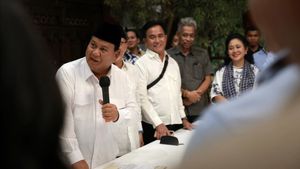JAKARTA - The results of a series of DNA tests conducted on tiger hair samples found in Sukabumi Regency, West Java, on August 19, 2019, confirmed the scientists' belief about the existence of Javanese tigers.
Researcher at the Research Center for Biosystematics and Evolution of BRIN Wirdateti said the comparison results between tiger hair samples in Sukabumi showed a 97.06 percent resemblance to Sumatran tigers and 96.87 percent with benggal tigers.
"Meanwhile, the Javan tiger specimen collection of the Zoologicalcum Bogoriense Museum (MZB) has 98.23 percent resemblance to the Sumatran tiger," he said in a statement quoted by ANTARA, Monday, March 25.
In addition to finding hair samples, tiger-like scratch marks were also found at the location.
Wirdateti explained that the results of a phylogenetic tree study showed that samples of sukabumi tiger hair and tiger specimens collected by the Zoologicalum Museum in Bogoriense were in the same group, but were separated from other tiger sub-species groups.
Furthermore, the Javan leopard is based on samples obtained from the specimens of the Zoologicalum Museum in Bogoriense.
According to him, DNA genetic analysis has the level of sensitivity needed to answer conservation questions and clarify taxonomy uncertainty.
Scientists then reconstructed the phylogeography and demographics to investigate the genetic progenitors of subspecies.
The total DNA extraction carried out using Denyasy Blood & Tissue Kites according to protocol. The protocol has been modified by adding protection, due to the high protein content in the hair.
"The PCR amplification of the entire cytochrom b mtDNA is carried out with a special primary for tigers. Furthermore, all nucleotide sequence results are stored using BioEdit and submitted to GenBank," said Wirdateti.
The complementary order between primary forward and reverse was edited using Chromas Pro. All sequences of nukelotides suspected of Javan tigers are compared to Genbank National Center for Biotechnology Information (NCBI) sequence data.
SEE ALSO:
DNA alignment is carried out using Cluster X and data is analyzed using MEGA.
A Javanese tiger called Latin Panthera tigris sondai is an endemic animal on the island of Java and is widely spread in lowland forests, shrubs, and plantations. Hunting activities and land management changes made the existence of the largest cat species disappear.
The International Union for Conservation of Nature (IUCN) red list categorized Javan tigers since the 1980s and a Balinese tiger named Latin Panthera tigris balica as extinct based on an assessment in 2008 from IUCN.
The last sight of a Javanese tiger was confirmed at Meru Betiri National Park, East Java, in 1976. Currently only a Sumatran tiger called the Latin Panthera tigris Sumatra which is still left in Indonesia.
Although hair and claw samples were found in South Sukabumi, scientists still have not dared to state that Javanese tigers are in the wild because these conditions still need to be confirmed with further genetic and field studies.
The English, Chinese, Japanese, Arabic, and French versions are automatically generated by the AI. So there may still be inaccuracies in translating, please always see Indonesian as our main language. (system supported by DigitalSiber.id)


















